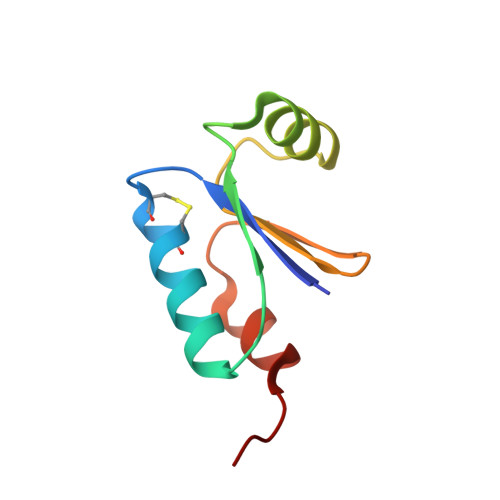NrdH-redoxin of Mycobacterium tuberculosis and Corynebacterium glutamicum Dimerizes at High Protein Concentration and Exclusively Receives Electrons from Thioredoxin Reductase.
Van Laer, K., Dziewulska, A.M., Fislage, M., Wahni, K., Hbeddou, A., Collet, J.F., Versees, W., Mateos, L.M., Tamu Dufe, V., Messens, J.(2013) J Biol Chem 288: 7942-7955
- PubMed: 23362277
- DOI: https://doi.org/10.1074/jbc.M112.392688
- Primary Citation of Related Structures:
4FIW - PubMed Abstract:
NrdH-redoxins are small reductases with a high amino acid sequence similarity with glutaredoxins and mycoredoxins but with a thioredoxin-like activity. They function as the electron donor for class Ib ribonucleotide reductases, which convert ribonucleotides into deoxyribonucleotides. We solved the x-ray structure of oxidized NrdH-redoxin from Corynebacterium glutamicum (Cg) at 1.5 Å resolution. Based on this monomeric structure, we built a homology model of NrdH-redoxin from Mycobacterium tuberculosis (Mt). Both NrdH-redoxins have a typical thioredoxin fold with the active site CXXC motif located at the N terminus of the first α-helix. With size exclusion chromatography and small angle x-ray scattering, we show that Mt_NrdH-redoxin is a monomer in solution that has the tendency to form a non-swapped dimer at high protein concentration. Further, Cg_NrdH-redoxin and Mt_NrdH-redoxin catalytically reduce a disulfide with a specificity constant 1.9 × 10(6) and 5.6 × 10(6) M(-1) min(-1), respectively. They use a thiol-disulfide exchange mechanism with an N-terminal cysteine pKa lower than 6.5 for nucleophilic attack, whereas the pKa of the C-terminal cysteine is ~10. They exclusively receive electrons from thioredoxin reductase (TrxR) and not from mycothiol, the low molecular weight thiol of actinomycetes. This specificity is shown in the structural model of the complex between NrdH-redoxin and TrxR, where the two surface-exposed phenylalanines of TrxR perfectly fit into the conserved hydrophobic pocket of the NrdH-redoxin. Moreover, nrdh gene deletion and disruption experiments seem to indicate that NrdH-redoxin is essential in C. glutamicum.
Organizational Affiliation:
Department of Structural Biology, Vlaams Instituut voor Biotechnologie, 1050 Brussels, Belgium; Structural Biology Brussels, Vrije Universiteit Brussel, 1050 Brussels, Belgium; Brussels Center for Redox Biology, 1050 Brussels, Belgium.
















